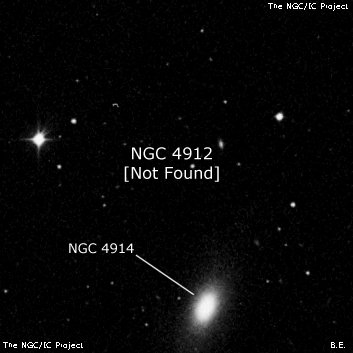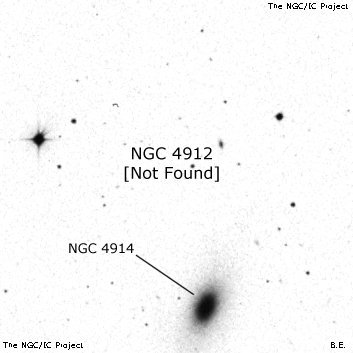NGC/IC Project Restoration Effort
(This is a very very beta version)
NGC4912


Basic Information
Location and Magnitude
Right Ascension: 13:0:46.0
Declination: +37:22:42
Constellation: CVN
Visual Magnitude:
Historic Information
Discoverer: Parsons L.
Year of discovery: 1865
Discovery aperture: 72.0
Observational
Summary description: Two neb, n of and in line with h 1514 (?)
Sub-type: NF
Corwin's Notes
=====
NGC 4912, 4913, 4914, 4916. [I wrote the following five paragraphs probably
around 2003 or 2004. There is an addendum; see below after the next
bracketted note.]
Of these galaxies, only one -- NGC 4914 -- can now be identified. That one
was found by WH and reobserved by JH; neither found any other nebulae in the
area.
The other three were seen only once by Lord Rosse, on 24 April 1865. He has a
sketch showing their relationship with the surrounding star field, so it ought
to be easy to identify them. His sketch, however, bears no relationship to
the sky around NGC 4914, so it seems likely that he misidentified the main
galaxy. Dreyer took this possibility into account by questioning the
identification of the main galaxy in the descriptions of N4912, 4913, and
4916.
A search of the four POSS1 fields around N4914 also turned up nothing that
matches the sketch. Another possibility is that LdR made a 10 deg error in
his position, and actually observed several galaxies in the Coma Cluster. But
that is about 10 deg 25+- arcmin south, and there are no galaxies/stars in the
cluster area that match his sketch. One hour errors are also possible, but
I've not yet looked closely at those.
The next thing to do will be to look into the lists of nebulae that Lord Rosse
had at his disposal at the time (e.g. JH's 1833 observations, the GC,
d'Arrest, Auwers) to see if any objects listed near NGC 4914 might be the one
that he observed. Since the pattern in his sketch is clear (3 of the objects
in a north-south line with a 4th following the southern most), it should jump
out at us when we see it. I hope.
Wolf claimed to have found and measured NGC 4912 and NGC 4916 on his plate
with the IC objects from his fifth list. The object he took as N4912,
however, is a star, and his N4916 is a defect (which he did not mark) on the
plate. There is nothing in its position on POSS1.
[I added the following in December 2008 after some email discussion with Sue
French.]
In November 2008, Sue French, Ron Buta, and I all bought originals of Lord
Rosse's lists of nebulae from the 7th earl (our thanks to Andy Stephens for
his kind assistance as Lord Rosse's agent). A correspondence between Sue and
me followed in which I pointed out the usefulness of the lists in tracking
down lost nebulae. I brought up the case of NGC 4914 and its missing
companions as an example, and it was not long before Sue suggested that the
quartet of galaxies formed by NGC 4922, IC 843, IC 4088, and CGCG 160-107 --
roughly eight degrees south of the nominal positions -- might be the correct
objects. This would require IC 4088, the third brightest of the four, to have
been mistaken for NGC 4914.
There is, in fact, a pretty good match between LdR's diagram and the field
around NGC 4922. The four galaxies are shown in their correct relative
positions, and LdR's description of their situation is accurate: "4 neb, 3
nearly in a line n s and one f ... A line through the 3 p nebulae is a little
concave on the p side." Two of the field stars are also shown in their
correct places and in the correct orientation between two of the galaxies.
A third "star" ([alpha] in the diagram), however, around which LdR suspected
nebulosity, is well off its sketched position. Sue suggests that this "star"
is the compact galaxy 2MASX J13002111+2920135. This matches the description,
but the object is quite faint compared to field stars not diagrammed and
closer to the galaxies. There are also a couple of other galaxies in the
field which LdR might have been able to see, including IC 842.
LdR's relative brightnesses for the galaxies are also jumbled. He says
"[beta] brightest and lE np sf, [gamma] and [delta] next and [epsilon] vF".
If the field is indeed the one he saw, NGC 4922 is [delta], [gamma] is IC 843,
[epsilon] is CGCG 160-107, and [beta] is IC 4088. This last galaxy is
actually quite extended, but directly east-west. NGC 4922, the brightest of
the group, is a close double interacting system, with the two objects oriented
southwest-northeast, just opposite LdR's note for the brightest object that he
saw.
So, while the general layout of the sketch matches what we see on the sky
pretty well, some of the details are wrong. And there is that 8-degree
declination error, too ...
In the end, I like Sue's suggestion, but I'm only reasonably sure that it
points us at the right field. Consequently, I feel compelled to put question
marks on the identifications of LdR's three novae, NGC 4912, 4913, and 4916.
Steve's Notes
=====
NGC 4912
See observing notes for NGC 4922.



